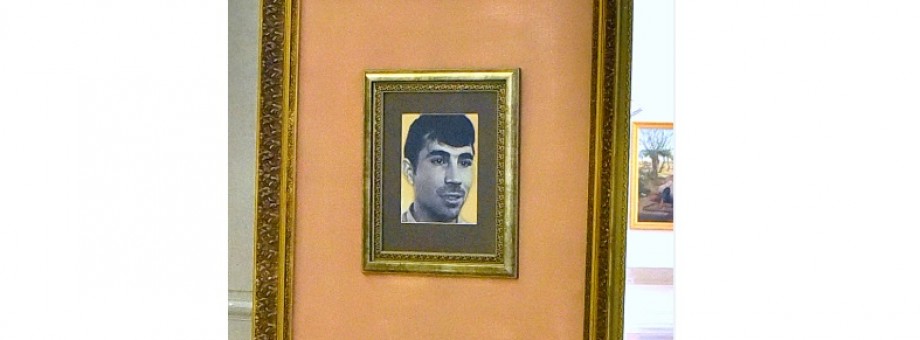FROM IDEA TO REALIZATION: DEDICATION TO MAMED MAMEDOV

Mamed Mamedov is regarded among the seven distinguished artists of the 1960s, whose names are closely associated with one of the brightest periods in the history of Turkmen painting. Mamed Mamedov, Durdy Bairamov, Shajan Akmuhammedov, Stanislav Babikov, Gulnazar Bekmuradov, Chary Amangeldyev and Juma Jumadurdy, whose families were on friendly terms, were spiritually close and offered each other their helpful advice. The permanent collection of the Museum of Fine Arts boasts the portrait of these artists, “The Seven” by Kakajan Oraznepesov.
When choosing his profession, Mamed, who was brought up in the Tejen Children’s Home, entered Turkmen State Art School. It was a fateful decision, painting fascinated him deeply. On leaving the school, he studied at I. E. Repin Institute of Painting, Sculpture and Architecture in the city of Leningrad.
“The portrait of composer Nury Halmamedov” is highly symbolic in his oeuvre. This painting reveals the commonality between the master artist and the great composer. There is a large array of works by Turkmen painters depicting Nury Halmamedov; however one look at Mamed Mamedov’s painting is enough to remember it forever. In the same way, to hear a piece of music by Nury Halmamedov once means to become a true lover of his works.
Mamed Mamedov had much in common with the outstanding composer. They were the best friends, the boys, who lived in a children’s home in the stern post-war period, and both possessed natural talent and became famous while alive. They died young at the peak of their abilities, not having the chance to create more. But they truly left their mark in the national culture.
Mamed Mamedov depicted the composer with his cheek touching a mulberry – a powerful and vigorous tree, reflecting the maestro’s personality. The artist managed to accurately capture Nury Halmamedov’s charisma and the strength of his musical talent with red, yellow and brown, dominating the painting.
It was typical of the many-faceted artist to create paintings differently from others. For instance, still-life paintings (celebrating the bounties of fertile Turkmen land) by Turkmen painters are a riot of colour, while his still-life painting shows a black dish exquisitely contrasted with white grapes and ruby pomegranates. He was able to see the beauty in everything and was incredibly skillful at painting.
When a student at the Repin Institute, Mamed Mamedov created the easel painting “Opening of the Karakum Canal” as his graduation work. He was very much aware that water was held sacred in his native country. Therefore, in his painting, dwellers from all near-by villages hurry to witness the man-made miracle that brings precious water.
An elderly man astride a camel raises himself in the saddle to see something that seemed unlikely to come true...
It seems that the painting “The Prayer for Water”, which was produced four years after the painting “Opening of the Turkmen Canal” should be placed first chronologically. In this context, it could be possible to evaluate the importance of the Karakum Canal for the Turkmen nation. “The Prayer for Water” shows the drought that threatens lives of the people in desert areas. Women and children severely suffering from thirst desperately pray for rain. It all happened in the past, but it is different now.
Going through the archive documents, the artist’s spouse Galina Mamedova found a small piece of the drawing that shows the knee of a woman, bending down and holding her hands up. Mamed Mamedov created the pencil drawing approximately in 1954. Consequently, the idea of creating the painting “The Prayer for Water” came to the artist in his student years.
The scientific and technological advances totally amazed elderly people, and the artist loved to reflect the theme. A graphic painting by Mamed Mamedov features an old man, who has never flown by airplane before. Clutching tightly his dutar to his chest, he feels tense and yet curious: the huge iron machine flies like a bird. A passenger next to him reads a book and is perfectly at ease.
The painting “The Talk about Universe” has a touch of fantasy: the large disk-shaped moon, silver shades, slightly elongated figures, and clothes somewhat resembling the attire of ancient Greek philosophers. Possibly, these serve to highlight the inner emotions of old men, who have just come to know about other worlds and feel slightly confused by the new information.
Social realism, which was the main genre of painting at that time, did not prevent Mamed Mamedov from making the most of his talent. He devoted his fine easel paintings to working people, and expanded his collection by painting portraits of outstanding contemporaries and ordinary people alike.
Produced in vivid and cheerful colors, the painting “Irrigators” dates back to 1985. It conveys much air and light, and the atmosphere of collective labor. And at the same time, the painting strikingly reveals the peasants’ faces not clearly depicted. This is the artist’s last and unfinished work. Working on it, he died untimely aged 47 in his studio at the hands of his colleagues Galina Saurova and Alexander Saurov.
To mark the 80th anniversary of Mamed Mamedov’s birth, the Museum of Fine Arts features a large exhibition of his works in several halls. The organizers entitled it “From Idea to Realization”, because aside from paintings and graphic works, the exhibition displays sketches with ideas that were never to come true. The section of pencil sketches is a big draw for the Academy’s students, who highly appreciate the opportunity to trace how the great master created his painting. Visitors to the exhibition found real enjoyment in exploring Mamed Mamedov’s creative legacy – patriotic, striking and talented.


 NEWS
NEWS